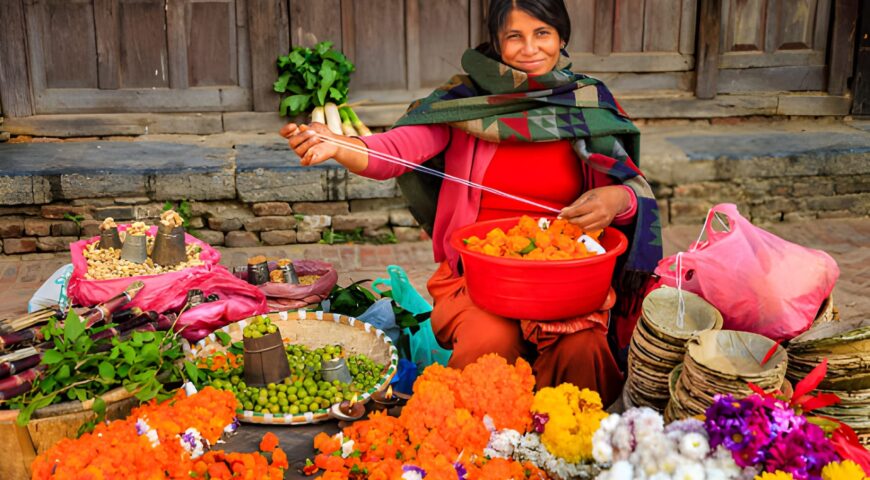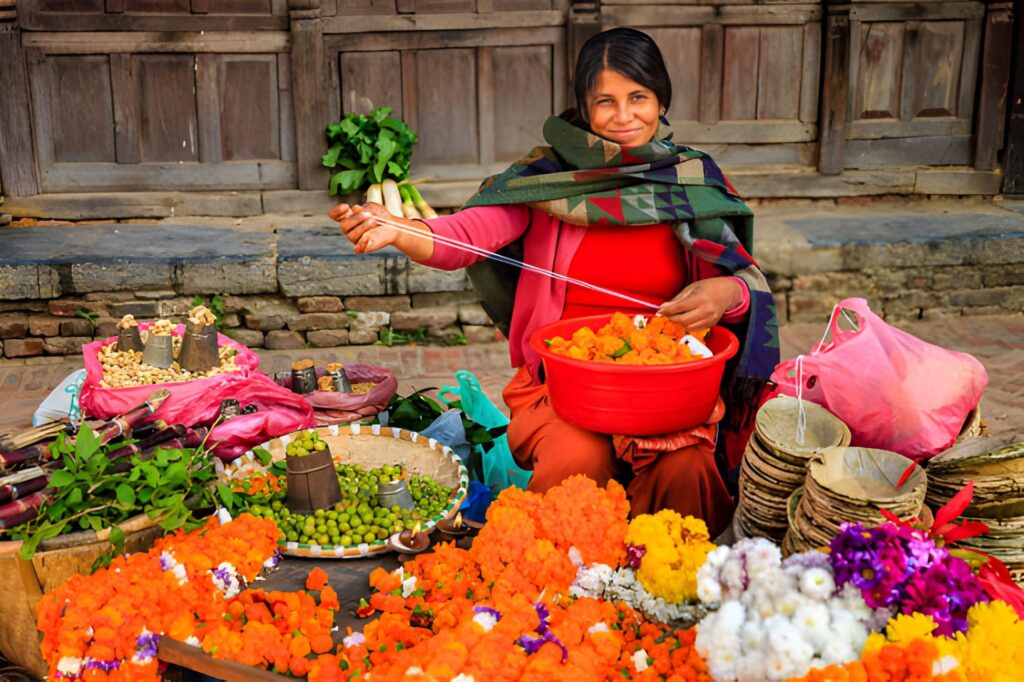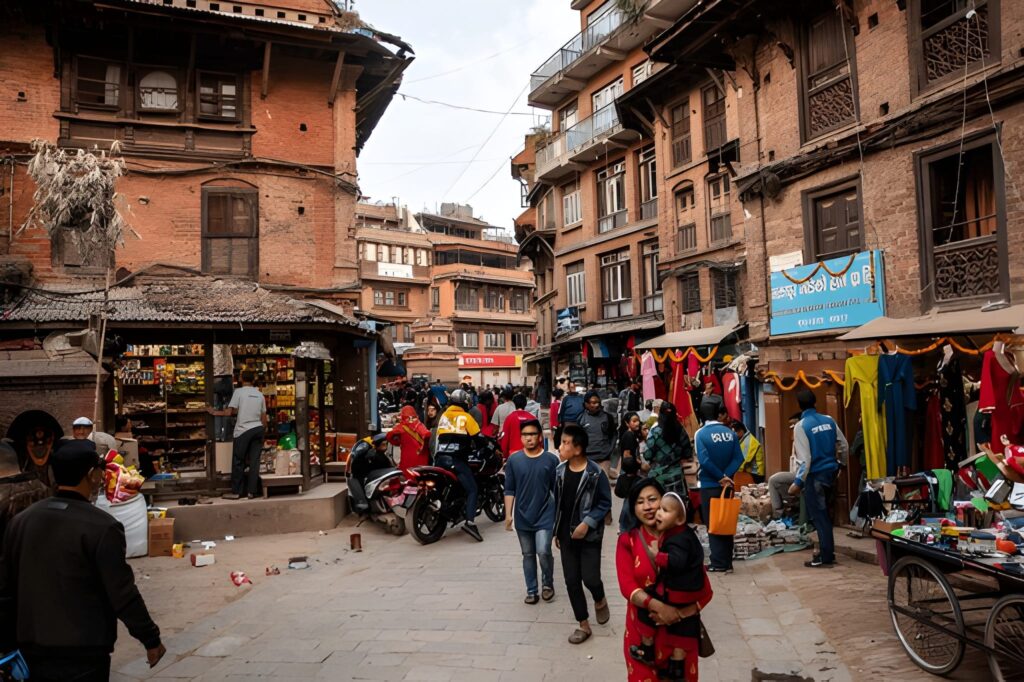
Tihar: Experience Nepal’s Festival of Lights
There’s something quite magical about Nepal in autumn. The air turns crisp, the Himalayan peaks gleam under clear blue skies, and across the country, homes begin to shimmer with thousands of tiny lights. This is Tihar – Nepal’s beloved festival of lights, a five-day celebration that transforms the entire nation into a canvas of warmth, gratitude, and joy.
If you’ve been searching for an authentic cultural experience that touches your heart as much as it dazzles your eyes, Tihar offers exactly that. This isn’t just another festival you’ll observe from the sidelines. It’s an invitation to witness something truly special – a celebration where every living being, from the smallest crow to your own soul, receives honour and gratitude.

What Makes Tihar Different?
You might have heard of Diwali, the Indian festival of lights. Tihar shares some similarities, but Nepal’s version carries its own distinctive character. Whilst both festivals celebrate light triumphing over darkness, Tihar extends its gratitude beyond humans to embrace all creatures that share our world.
This unique perspective makes Tihar feel wonderfully inclusive. Over five days, you’ll see an entire nation pause to appreciate relationships we often take for granted with animals, with nature, with family, and even with ourselves. It’s refreshing, really. In our fast-paced modern world, how often do we stop to thank a crow for bringing news, or honour a dog for its unwavering loyalty?
Day One: Kaag (Crow) Tihar – Honouring the Messengers
The festival begins with something unexpected. On the first day, Nepalis pay tribute to crows. Yes, those clever black birds you’ll spot perched on temples and rooftops throughout Kathmandu and beyond.
In Hindu mythology, crows serve as messengers of Yama, the god of death. They’re believed to bring news and warnings. On Kaag Tihar, families place offerings of sweets and food on their rooftops and in their gardens. You’ll see crows swooping down to accept these gifts whilst families watch with genuine affection.
Walking through Nepali neighbourhoods on this day reveals something touching about the culture. People here don’t see these birds as pests or nuisances. They’re recognised as part of the ecosystem, deserving of respect and care. It sets the tone beautifully for what follows.
Day Two: Kukur (Dog) Tihar – Celebrating Our Loyal Friends
If you’re a dog lover, the second day of Tihar will steal your heart completely. Kukur Tihar is dedicated entirely to dogs -both pets and street dogs alike.
Picture this: throughout Nepal, every dog receives a tika (a coloured powder mark) on their forehead, a beautiful flower garland around their neck, and special treats to feast upon. Street dogs that normally scavenge for food suddenly find themselves honoured guests, receiving the same blessings as cherished family pets.
The symbolism runs deep. Dogs represent loyalty, protection, and unconditional love. In Hindu tradition, dogs guard the gates of the afterlife. By honouring them, Nepalis acknowledge these qualities and the special bond between humans and their canine companions.
You’ll find it genuinely moving. In Kathmandu’s Thamel district or Pokhara’s lakeside neighbourhoods, even the scruffiest street dog wears its garland with dignity. Children approach them gently with offerings. The usual barriers between “owned” and “stray” dissolve for this one special day.

Day Three: Laxmi Puja – The Heart of Tihar
The third day marks the festival’s centerpiece. Laxmi Puja transforms Nepal into a constellation of lights that rivals the stars above.
As dusk approaches, families begin their preparations. Homes are cleaned thoroughly – not just tidied, but made spotless. Doorways and windows receive intricate rangoli designs created from coloured rice powder and flower petals. Then, as darkness falls, the lights appear.
Diyas – small clay oil lamps, line windowsills, doorsteps, and garden paths. Candles flicker in every corner. Strings of electric lights drape across balconies and rooftops. The effect is breathtaking. Entire cities glow with a warmth that feels almost alive.
This illumination serves a purpose beyond beauty. Goddess Laxmi, the deity of wealth and prosperity, is believed to visit homes on this night. The lights guide her way, welcoming her blessing into clean, prepared spaces. Families gather for prayer ceremonies, singing devotional songs that drift through neighbourhoods, creating a soundtrack of faith and hope.
What strikes visitors most isn’t the spectacle itself, though that’s impressive enough. It’s the intention behind it. Every lit lamp represents gratitude for what families have and hope for continued blessings. There’s no ostentation here, no competition for the brightest display. Just quiet, earnest devotion expressed through light.

Day Four: Gai Tihar and Mha Puja – Honouring Sacred Life
The fourth day actually holds two celebrations that reveal different facets of Nepali culture.
Gai Tihar honours the cow, an animal held sacred across Nepal. You’ll see cows adorned with garlands, their foreheads marked with tika, receiving special food offerings. In Hindu tradition, the cow symbolises motherhood and the earth’s generosity. Its presence in homes is considered auspicious.
For Nepal’s Newar community – the indigenous people of the Kathmandu Valley- this day holds additional significance. They celebrate their new year with Mha Puja, a ritual that’s quite unique in the Hindu world.
Mha Puja literally means “worship of self.” Each person sits before a mandala – a sacred geometric design and performs rituals honouring their own body and soul. It’s not about ego or vanity. Rather, it’s a profound acknowledgment that you cannot truly care for others or the world around you without first respecting and nurturing yourself.
This concept resonates deeply with modern wellness philosophies, yet Newars have practised it for centuries. Watching families perform Mha Puja offers a window into this ancient wisdom, reminding us that self-care is actually sacred duty.
Day Five: Bhai Tika – The Bond Between Siblings
Tihar concludes with Bhai Tika, a celebration of sibling relationships that carries genuine emotional weight.
Sisters perform an elaborate tika ceremony for their brothers, marking their foreheads with seven colours arranged in a specific pattern. Each sister places a garland around her brother’s neck, offers him sweets, and most importantly, prays for his long life, prosperity, and protection from harm.
Brothers, in turn, pledge to protect and support their sisters throughout life. They typically give gifts as tokens of appreciation and love.
The ceremonies happen in homes throughout Nepal, but if you witness them, you’ll notice something special. There are often tears alongside the smiles. These aren’t empty rituals performed out of obligation. They’re heartfelt expressions of familial bonds that form the bedrock of Nepali society.
Sisters and brothers separated by distance or circumstance travel hours, sometimes days to reunite for Bhai Tika. The festival won’t feel complete without it. That dedication speaks volumes about what family means here.

Why Experience Tihar in Nepal?
You could read about Tihar or watch videos online. But being present for this festival offers something no screen can capture, the feeling of a whole nation radiating collective joy.
The autumn timing is perfect. After the monsoon rains, Nepal’s skies are brilliantly clear. Mountain views are spectacular. The weather is comfortable for exploring, neither too hot nor too cold. And with Tihar lighting up cities, villages, and countryside alike, you’ll experience Nepal at its most enchanting.
Beyond the visual spectacle, Tihar offers genuine cultural insight. You’ll see what Nepalis value most gratitude, relationships, and respect for all living beings. These aren’t abstract concepts here. They’re lived daily, and during Tihar, they’re celebrated openly.
The festival also makes Nepal feel remarkably welcoming to visitors. Locals are proud to share their traditions. You’ll find people happy to explain the significance of rituals, invite you to observe ceremonies, and include you in celebrations. There’s a generosity of spirit during Tihar that makes foreign guests feel less like tourists and more like honoured visitors.

Practical Considerations
Tihar follows the lunar calendar, so dates shift each year, typically falling in October or November. The festival atmosphere actually extends beyond the official five days, with preparations beginning earlier and celebrations continuing after.
You’ll find accommodation readily available, though booking ahead is wise, particularly in popular areas like Kathmandu, Pokhara, and Chitwan. Hotels and guesthouses often host their own Tihar celebrations, lighting up their properties beautifully and sometimes including guests in festivities.
The festival doesn’t disrupt travel plans. Tourist services continue operating, though some local shops and offices may close during peak celebration days. If anything, Tihar enhances your Nepal experience, adding cultural depth to your visit.
Come prepared with your camera, certainly. But also come prepared to put it down sometimes and simply be present. Some moments like watching a child carefully place a garland on a street dog, or seeing an elderly grandmother light diyas with trembling hands deserve to be experienced rather than documented.
More Than a Festival
After five days of Tihar, visitors often describe feeling changed somehow. Not dramatically, but subtly. Perhaps it’s the reminder that gratitude can be a daily practice. Maybe it’s witnessing how even simple lights can create profound beauty. Or possibly it’s seeing a society that genuinely tries to honour all creatures great and small.
Tihar reveals Nepal glowing from the inside out, as much from warmth of spirit as from thousands of lamps. It’s Nepal being authentically itself not performing for tourists, but simply living its values and celebrating life with characteristic kindness and grace.
This is what travel should be. Not just seeing new places, but feeling them. Not just observing different cultures, but letting them touch something in you.
Experience Tihar With Us
Nepal during Tihar isn’t just a destination it’s a feeling you’ll carry home with you. The memory of lights reflecting in children’s eyes, the sound of prayer songs drifting through autumn evenings, the sight of every dog in the city wearing flowers with quiet dignity.
We’d be honoured to help you experience this magical time. Our team knows Nepal intimately, understands the festival’s rhythms, and can position you to witness Tihar’s most meaningful moments whilst respecting local customs and spaces.
Whether you’re seeking cultural immersion, photographic opportunities, or simply want to experience something genuinely different, we’ll craft an itinerary that matches your interests and travel style.
The lights of Tihar are waiting. The welcome is genuine. Nepal is ready to share something special with you.
Let’s plan your journey together. Reach out to us today, and let’s create your perfect Tihar experience in Nepal. Because some moments in life deserve to be extraordinary – and autumn in Nepal, with the glow of Tihar all around you, is definitely one of them.
